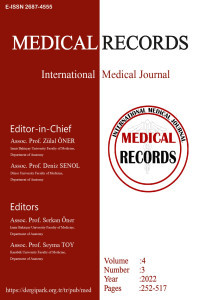Investigation of Insulin-Like Growth Factor 1 Receptor Expression in Cases of Sacrococcygeal Pilonidal Sinus
Investigation of Insulin-Like Growth Factor 1 Receptor Expression in Cases of Sacrococcygeal Pilonidal Sinus
Sacrococcygeal Pilonidal Sinus, IGF-1R, keratinocytes,
___
- 1. Nixon AT, Garza RF. Pilonidal cyst and sinus. StatPearls. 2023.
- 2. de Parades V, Bouchard D, Janier M, Berger A. Pilonidal sinus disease. J Visc Surg. 2013;150:237-47.
- 3. Hap W, Frejlich E, Rudno-Rudzinska J, et al. Pilonidal sinus: finding the righttrack for treatment. Pol Przegl Chir. 2017;89:68-75.
- 4. Halleran DR, Onwuka AJ, Lawrence AE, et al. Laser hair depilation in the treatment of pilonidal disease: a systematic review. Surg Infect (Larchmt). 2018;19:566-72.
- 5. Can A. Hair follicle stem cells and intrafollicular homeostasis. Turkderm-Turk Arch Dermatol Venereol. 2014;48:6-9.
- 6. Garza LA, Liu Y, Yang Z, et al. Prostaglandin d2 inhibits hair growth and is elevated in bald scalp of men with androgenetic alopecia. Sci Transl Med. 2012;4:126ra34.
- 7. Muraguchi T, Nanba D, Nishimura EK, Tashiro T. Igf-1r deficiency in human keratinocytes disrupts epidermal homeostasis and stem cell maintenance. J Dermatol Sci. 2019;94:298-305.
- 8. Loesch MM, Collier AE, Southern DH, et al. Insulin-like growth factor-1 receptor regulates repair of ultraviolet b-induced dna damage in human keratinocytes in vivo. Mol Oncol. 2016;10:1245-54.
- 9. Duchateau J, De Mol J, Bostoen H, Allegaert W. Pilonidal sinus. Excision--marsupialization--phenolization? Acta Chir Belg. 1985;85:325-8.
- 10. Chintapatla S, Safarani N, Kumar S, Haboubi N. Sacrococcygeal pilonidal sinus: historical review, pathological insight and surgical options. Tech Coloproctol. 2003;7:3-8.
- 11. Karydakis GE. Easy and successful treatment of pilonidal sinus after explanation of its causative process. Aust NZJ Surg. 1992;62:385-9.
- 12. Mustafa G, Akber G, Lodhi JK, et al. Umbilical pilonidal sinus. J Ayub Med Coll Abbottabad. 2014;26:100-1. 13. Isik A, Idiz O, Firat D. Novel approaches in pilonidal sinus treatment. Prague Med Rep. 2016;117:145-52.
- 14. Weale FE. The hair of the pilonidal sinus. Lancet. 1955;268:230-1.
- 15. Stelzner F. Causes of pilonidal sinus and pyoderma fistulans sinifica. Langenbecks Arch Chir. 1984;362:105-18.
- 16. Dahl HD, Henrich MH. Light and scanning electron microscopy study of the pathogenesis of pilonidal sinus and anal fistula. Langenbecks Arch Chir. 1992;377:118-24.
- 17. Gosselink MP, Jenkins L, Toh JWT, et al. Scanning electron microscope imaging of pilonidal disease. Tech Coloproctol. 2017;21:905-6.
- 18. Yousef H, Alhajj M, Sharma S. Anatomy, skin (integument), epidermis. StatPearls. 2023.
- 19. Alyoussef A. The therapeutic effects of blocking igf-r1 on mice model of skin cancer. J Dermatolog Treat. 2021;32:803-11.
- 20. Federici M, Porzio O, Zucaro L, et al. Distribution of insulin/insulin-like growth factor-I hybrid receptors in human tissues. Mol Cell Endocrinol. 1997;129:121-6.
- 21. Forbes BE, Blyth AJ, Wit JM. Disorders of igfs and igf-1r signaling pathways. Mol Cell Endocrinol. 2020;518:111035.
- 22. Annunziata M, Granata R, Ghigo E. The igf system. Acta Diabetol. 2011;48:1-9.
- 23. Le Roith D. The insulin-like growth factor system. Exp Diabesity Res. 2003;4:205-12.
- 24. Pardee AB. G1 events and regulation of cell proliferation. Science. 1989;246:603-8.
- 25. Rudman SM, Philpott MP, Thomas GA, Kealey T. The role of igf-i in human skin and its appendages: morphogen as well as mitogen? J Invest Dermatol. 1997;109:770-7.
- 26. Lewis DA, Travers JB, Somani AK, Spandau DF. The igf-1/igf-1r signaling axis in the skin: a new role for the dermis in aging-associated skin cancer. Oncogene. 2010;29:1475-85.
- 27. Liu JP, Baker J, Perkins AS, et al. Mice carrying null mutations of the genes encoding insulin-like growth factor i (igf-1) and type 1 igf receptor (igf1r). Cell. 1993;75:59-72.
- 28. Barkan AL, Beitins IZ, Kelch RP. Plasma insulin-like growth factor-I/somatomedin-c in acromegaly: correlation with the degree of growth hormone hypersecretion. J Clin Endocrinol Metab. 1988;67:69-73.
- 29. Selman C, Lingard S, Choudhury AI, et al. Evidence for lifespan extension and delayed age-related biomarkers in insulin receptor substrate 1 null mice. FASEB J. 2008;22:807-18.
- 30. Knuever J, Willenborg S, Ding X, et al. Myeloid cell-restricted insulin/igf-1 receptor deficiency protects against skin inflammation. J Immunol. 2015;195:5296-308.
- Yayın Aralığı: Yılda 3 Sayı
- Başlangıç: 2019
- Yayıncı: Zülal ÖNER
Hasan Esat YÜCEL, Tufan ULCAY, Ozkan GORGULU, Kağan TUR, Muhammed Hüseyin KIRINDI, Elif ÇÖMLEKÇİ, Emre UĞUZ, Berat YAĞMUR, Burcu KAMAŞAK, Ahmet UZUN
Ankle Bone Anatomy in Turkish Population: A Radiological Study
Aybars KIVRAK, İbrahim ULUSOY, Mehmet YILMAZ
Classification of Bovine Cumulus-Oocyte Complexes with Convolutional Neural Networks
Türker ÇAVUŞOĞLU, Aylin GÖKHAN, Cansın ŞİRİN, Canberk TOMRUK, Kubilay Doğan KILIÇ, Emre ÖLMEZ, Orhan ER, Kemal GÜLLÜ
MATERNAL BISPHENOL-A'NIN SIÇAN BÖBREK GELİŞİMİ ÜZERİNDEKİ ETKİSİNİN İNCELENMESİ
Dilek MEYDAN, Semih TAN, Saim ÖZDAMAR, Hülya ÇETİN
Lomber Disk Hernili Hastalarda Q açısı ve Hamstring Uzunluğunun Denge Performansına Etkisi
Prediction of Short or Long Length of Stay COVID-19 by Machine Learning
Muhammet ÖZBİLEN, Zübeyir CEBECİ, Aydın KORKMAZ, Yasemin KAYA, Kaan ERBAKAN
The Use of Botulinum Toxin in Temporomandibular Disorders: A Bibliometric Study
Serkan YILDIZ, Feridun ABAY, S. Kutalmış BÜYÜK
Investigation of the Sox-9 and Caspase-6 Immune Activity in Placentas of Pregnant Women with GDM
